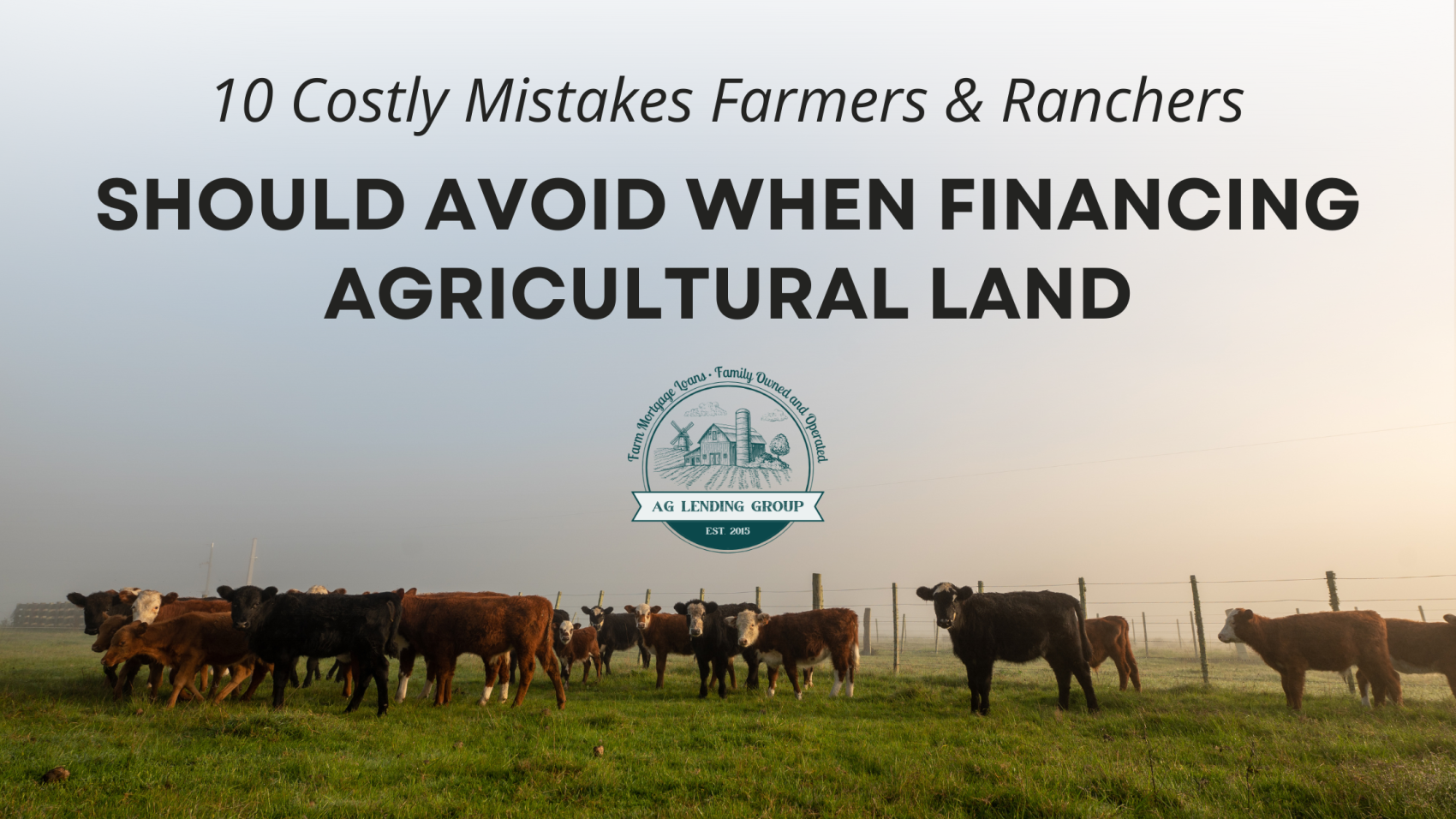
 Financing agricultural land is one of the most significant financial decisions a farmer or rancher will make. Whether you are purchasing new land, expanding your operation, or refinancing existing loans, the structure of your financing can have long-term consequences. Unfortunately, many producers make critical mistakes that put their entire operation at risk—often without realizing it.
Financing agricultural land is one of the most significant financial decisions a farmer or rancher will make. Whether you are purchasing new land, expanding your operation, or refinancing existing loans, the structure of your financing can have long-term consequences. Unfortunately, many producers make critical mistakes that put their entire operation at risk—often without realizing it.
At Ag Lending Group, we work with farmers and ranchers across the country to ensure their financing is strategic, sustainable, and structured for long-term success. Below are ten common financing mistakes we see and how to avoid them.
1. Cross-Collateralizing Land, Equipment, and Operating Loans
One of the biggest mistakes farmers and ranchers make is allowing their lender to cross-collateralize their mortgage, equipment, and operating loans. Many banks and farm credit institutions bundle everything together, meaning that if one loan falls into default, the lender has the right to seize all the assets tied to it—including land, equipment, and livestock.
How to avoid it: Keep your mortgage, equipment, and operating loans separate to protect your assets. At Ag Lending Group, we specialize in structuring financing that reduces risk and provides long-term financial security.
2. Not Shopping Around for the Best Loan Terms
Many farmers assume their local bank or farm credit lender offers the best rates and terms, so they do not compare other options. This can result in higher interest rates, less favorable loan structures, and missed opportunities for better financing solutions.
How to avoid it: Work with an experienced ag lending specialist who can shop multiple lenders to find the best financing package tailored to your operation’s needs.
3. Choosing Short-Term Loans for Long-Term Investments
Using short-term loans or balloon notes to finance land purchases can lead to financial stress when it is time to refinance. If interest rates rise or market conditions change, refinancing can become difficult and costly.
How to avoid it: Always match the length of your loan to the lifespan of the asset being financed. Land should be financed with long-term, fixed-rate loans that provide stability and predictable payments.
4. Overlooking Prepayment Penalties
Some loans include hidden fees or prepayment penalties, making it expensive to pay off debt early. These penalties can limit your ability to refinance or pay off the loan ahead of schedule.
How to avoid it: Always read the fine print and ask about prepayment penalties before signing any loan agreement.
5. Relying Entirely on an Operating Loan for Expenses
Operating loans are essential for cash flow, but depending solely on credit to cover expenses can be risky, especially during market downturns or unexpected events.
How to avoid it: Set aside a cash reserve for unexpected costs. A good rule of thumb is to have at least three to six months of operating expenses saved to provide financial stability.
6. Not Considering the Impact of Rising Interest Rates
Many producers assume that interest rates will remain low and take on variable-rate loans without considering future rate increases. This can lead to significantly higher payments if rates rise.
How to avoid it: Lock in fixed-rate loans for long-term stability, particularly for land and high-value assets.
7. Using Equipment Loans for Land Purchases
Some farmers and ranchers attempt to finance land purchases with short-term equipment loans, leading to high monthly payments and financial strain.
How to avoid it: Always finance land separately with a long-term loan designed for real estate. Equipment should be financed with appropriate short- or mid-term loans that align with the equipment’s lifespan.
8. Ignoring Tax Implications of Loan Structures
The structure of your loan can have significant tax implications, affecting interest deductions, depreciation, and overall financial planning.
How to avoid it: Work with an accountant or financial advisor to ensure that your loan structure aligns with your tax strategy and overall financial goals.
9. Not Having a Succession Plan in Place
Many farmers do not consider how their financing will impact the next generation when transitioning the farm or ranch. Without a clear plan, succession can become complicated, and heirs may face financial challenges.
How to avoid it: Develop a long-term financial and estate plan that includes financing strategies for a seamless transition to the next generation.
10. Trying to Handle Financing Alone
Agricultural financing is complex, and trying to navigate it alone can lead to costly mistakes. Many farmers and ranchers do not seek expert advice, assuming they can manage their financing without professional guidance.
How to avoid it: Work with ag finance specialists who understand the industry and can help you secure the best loan structure for your operation. Partnering with an expert can save you time, money, and unnecessary financial risk.
Work with Ag Lending Group to Get It Right
At Ag Lending Group, we help farmers and ranchers avoid these costly mistakes by structuring financing the right way. We focus on keeping land, equipment, and operating loans separate to protect your operation, reduce risk, and provide long-term financial flexibility.
If you are considering a loan or want to review your current financing, let’s talk. We will help you find the best solutions to keep your farm or ranch financially strong for years to come.
Call us today at (480) 659-9669
Visit us at www.aglendinggroup.com
Latest Articles
- Strategic Financial Planning: Positioning Your Operation for a Stronger New Year
- Why a Real Estate-Backed Line of Credit is a Smart End-of-Year Move
- November WASDE: What Farmers Should Know, and How to Navigate What’s Next
- How Farmers Can Prepare Their Financials for Year-End Success
- Keeping the Farm in the Family: How Ag Lending Group Helps Make It Possible